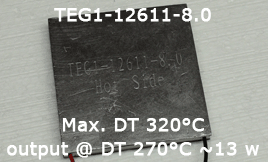To identify and research about the thermoelectric.
Analysis/Procedure:
The thermoelectric effect is the direct conversion of temperature differences to electric voltage and vice versa. The term "thermoelectric effect" encompasses three separately identified effects: the Seebeck effect, Peltier effect, and Thomson effect. Joule heating, the heat that is generated whenever a current is passed through a resistive material, is related though it is not generally termed a thermoelectric effect. A metal of unknown composition can be classified by its thermoelectric effect if a metallic probe of known composition is kept at a constant temperature and held in contact with the unknown sample that is locally heated to the probe temperature.

Figure 2: How thermoelectric module work
There is 2 type of thermoelectric module:
1. Thermoelectric Cooling (TEC) Module:
Figure 3: Thermoelectric Cooling (TEC) module
Thermoelectric cooling uses the Peltier effect to create a heat flux between the junction of two different types of materials. A Peltier cooler, heater, or thermoelectric heat pump is a solid-state active heat pump which transfers heat from one side of the device to the other, with consumption of electrical energy, depending on the direction of the current. Such an instrument is also called a Peltier device, Peltier heat pump, solid state refrigerator, or thermoelectric cooler (TEC). It can be used either for heating or for cooling,although in practice the main application is cooling. It can also be used as a temperature controller that either heats or cools.
2. Thermoelectric Generator (TEG) Module:

Figure 4: Thermoelectric Generator (TEG) module
Thermoelectric generators (also called Seebeck generators) are devices that convert heat (temperature differences) directly into electrical energy, using a phenomenon called the Seebeck effect (a form of thermoelectric effect).
The Seebeck effect is the conversion of temperature differences directly into electricity and is named after the Baltic German physicist Thomas Johann Seebeck. Seebeck, in 1821, discovered that a compass needle would be deflected by a closed loop formed by two different metals joined in two places, with a temperature difference between the junctions. This was because the metals responded to the temperature difference in different ways, creating a current loop and a magnetic field. Seebeck did not recognize there was an electric current involved, so he called the phenomenon the thermomagnetic effect. Danish physicist Hans Christian Ørsted rectified the mistake and coined the term "thermoelectricity".
In the video below will describe more detail the differences between Thermoelectric Cooling (TEC) module and Thermoelectric Generator (TEG) module.
Conclusion:
In conclusion, Thermoelectric Generator (TEG) module has been chosen for this project but there are several problems which I will be facing:
- How much voltage and current that i can get from Thermoelectric Generator (TEG)?
- How to install properly the Thermoelectric Generator (TEG)?
- Which range of temperature in between cold side and hot side that will gave best output voltage and current?
- http://www.thermoelectricgenerators.net/
- http://en.wikipedia.org/wiki/Thermoelectric_generator
- http://en.wikipedia.org/wiki/Thermoelectric_generator
- http://en.wikipedia.org/wiki/Thermoelectric_effect#Seebeck_effect
- http://citizenscientistsleague.com/2012/03/16/butane-fueled-experimental-thermoelectric-generator/
- http://www.thermoelectricgenerators.org/
- http://www.electricityfromheat.com/
- http://thermoelectric-generator.com/
- http://tecteg.com/
- http://www.devilwatt.com/
- http://www.tegpro.com/